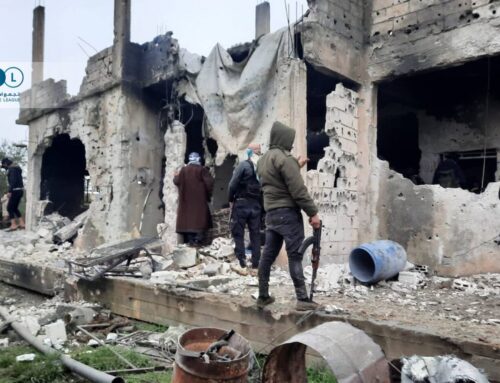Regime is “still strong with an iron grip on the coastal area”
May 3, 2013 Moataz, 28, is a dentistry student who […]
3 May 2013
May 3, 2013
Moataz, 28, is a dentistry student who asked that his last name be withheld for security reasons, comes from Ras a-Rifi in Banias. He was arrested by the Military Security in November 2011 and held until the following June. He was charged of forming armed gangs in the coastal area. The following is his analysis, as told to Ahmed Kwider, of why a massacre occurred in Banias this week, saying: “Both Obama and the regime have red lines. The difference is that Obama’s red lines are trivial, whereas the regime has serious red lines when it comes to the sensitive coastal areas. This is al-Assad’s [the lion’s] den that no one can dare approach it.”
An estimated 50,000-60,000 people live in the district of Banias. It’s divided into two sides; the first is the north, near Latakia, where Alawites live. It contains the neighborhoods of al-Fouz and al-Kusour. Then there is the south, where Sunnis live, in the neighborhoods of Ras a-Nabbea, Ras a-Rifi, al-Midan and al-Kabyat. Christians live with both Sunnis and Alawites. There are two churches, one Catholic and an Orthodox. Both of them are in the Sunni areas, as a result of a lasting peaceful co-existence until the revolution.
As for the rural areas, there are about 10 Sunni villages in the south and the southwest of the city. There are some Christian villages near the Sunnis. More than 150 Alawite villages surround the Sunni area from all sides. That’s why the regime feels they have the upper hand in the coastal area.
During the protests, one Christian guy, Hatem Hanna, was killed. The Christians continue to be neutral. Some dared to protest, and others expressed opinions [that backed the revolution].
My father has a Christian friend. He’s from the al-Faour family. He’s an English teacher and a certified translator who studied in the United States. He’s 50 years old. He was and continues to support the Syrian revolution by words and actions. Not long time ago I visited his place, which is between the Sunni and Alawite areas. He wasn’t afraid of criticizing the “regime’s actions, which will lead the country into a holocaust and a humanitarian disaster.” Some of his neighbors are Alawites and shabiha who support the regime.
There were cumulative motives for the regime’s brutal military campaign and systematic killing. In the beginning of the revolution, people protested in the main square of al-Baida village. Two weeks ago, the regime adopted a new policy to terrify the citizens. They sent the corpses of their sons after they died under torture. Sometimes they called them to go collect the corpses. That generated rage among the people.
Last week, the security arrested a famous activist in al-Baida named Hassan Othman. After interrogations, they got names of new activists. In the morning a patrol came to arrest those activists, but the men in the village refused to turn them in. They targeted the patrol and killed everyone in it.
The regime closed [the road] to the village and besieged it after that. I was in touch with my family on the phone. They told me “the regime besieged the village, but didn’t invade it. It was bombing it with artillery, tanks and naval boats from the sea.” A large part of a-Taqwa Mosque was destroyed and houses were damaged or burned.
The major areas that were bombed yesterday were the village of al-Baida, Ras a-Nabbea neighborhood, Ras a-Rifi neighborhood and Wati al-Baida, which is a farming area. This area includes valleys, like Batraya, where the regime thinks defected soldiers and gunmen take shelter. This area has been a shelter for many defected soldiers because of its rugged nature.
The tank and artillery bombardment came from the bad Alawite villages supporting the regime. These villages surrounded the area. That resulted in the displacement of many people in the villages. The security invaded the village after that and arrested all the citizens in it, including women, children and the elders. They killed them with all types of weapons and deformed their corpses with knives. They spread the corpses all over the village and the surrounding areas, then they withdrew. Some citizens started to come back and witnessed the massacre. We still don’t have a total death toll, but activists have documented 150 names so far. What’s notable is that some corpses belonged to people who used to support the regime. That means the killing was random. It also means those who executed these people were not official security, but members of the regime’s shabiha. Some people recognized some of those shabiha as Alawites from Banias.
The security and military status has not changed since the beginning of the uprising. Some activists inside Syria and abroad think the regime has become weaker after two years of the revolution, but this is incorrect. They are still strong with an iron grip on the coastal area, with the exception of Jabal Al-Akrad and Jabal Al-Turkman, which are liberated.
Both Obama and the regime have red lines. The difference is that Obama’s red lines are trivial, whereas the regime has serious red lines when it comes to the sensitive coastal areas. This is al-Assad’s [the lion’s] den that no one can dare approach it. [Al-Assad] has full control over the coastal area, and he doesn’t value other Syrian areas. The regime has no values or morals, and they don’t even respect religions.
The regime today sends a clear message through the daily massacres, the one in al-Baida is the latest, to the Syrian people inside Syria and abroad that “you will die and burn in horrifying massacres, as the international community and the world watch you. No one will come to rescue you. No one can confront us. Their promises to the people and the opposition are false.”






